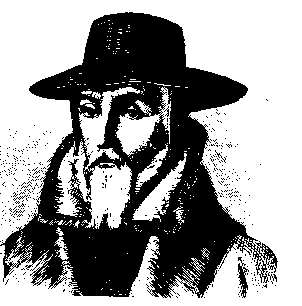

The following extract is from Boston Its Story and People by Geo. S. Bagley (1986).
In his most famous work, the so called Book of Martyrs, published in 1563, which became almost as much required reading as the Bible itself in Elizabethan England, John Foxe, the Boston-born martyrologist, gives a strange (and by no means reliable) account of the 1510 bid by the Boston Guild of St. Mary to obtain further indulgences from Julius II. It seems Geoffrey Chambers was sent to Antwerp to persuade Thomas Cromwell to undertake the journey to Rome on the guild’s behalf. Cromwell, who had spent some of his early manhood in Italy, and became Henry VIII’s right-hand man as Keeper of the Privy Seal, was ‘loth to spend much time, and more loth to spend his money’ on the undertaking. Cromwell realised that the Pope’s greedy humour must needs be served with some present or other’, and learned that ‘the Pope’s holy tooth greatly delighted in new fangled strange delicates’
So, says Foxe, it 'came into his minde to prepare certain fine dishes of gelly after the best fashion, made after our country manner here in England, which to them of Rome was not known or seen before'. Pope Julius, it seems, 'liked it so well' that, after demanding to know 'the making of that meat', he 'without any more adoe, stamped both their pardons . . . And thus were the jolly pardons of the towne of Boston obtained . . . for the maintenance of their decayed port'.
A guild member did go to Rome on that occasion: so much is certain. But whether Cromwell was involved, or if this was but a figment of Foxe's fervid anti-Catholic imaginings, is highly debatable. Be that as it may, one of the chief indulgences granted was that any member of the guild who had paid his admission fee of five shillings and eightpence, and twelvepence annually thereafter, and who attended the Lady Chapel in the 'Stump' on specified religious festivals, 'should have pardon no lesse than if they themselves personally had visited the stations of Rome'.
Foxe, born in 1516 in the market place house which later became the Bell inn (and stood on, or near, the site of the present Martha's Vineyard) was raised as a 'rigid Romanist', but became 'tainted' with Protestantism, and was deprived of, or resigned, his fellowship of Magdalen College, Oxford. He became tutor to the family of Sir Thomas Lucy of Charlecote (Warwicks.), and was ordained while living in the household of the Duchess of Suffolk, who appointed him tutor to the children of her nephew, Thomas, Earl of Surrey, then a prisoner in the Tower.
With the accession of Mary Tudor, Foxe fled the country, undertook literary work at Basic, in Switzerland, and did not return until Elizabeth I had succeeded her half-sister. Now much impoverished, he had a pension settled on him by his former pupil, Thomas Howard, who succeeded his father as Earl of Surrey and Duke of Norfolk - and Foxe was on the scaffold that June day in 1572 to witness the execution of his young patron for complicity in the Ridolfi plot, which had aimed at placing Mary Queen of Scots on the English throne.
The Following extract is from The
History and Antiquities of Boston by Pishey Thompson (1856).
|
|
This portion of the Market-place was at this period (18th cent.) so different to what it is now, that we scarcely know how to make ourselves understood when attempting to describe it. The house now fronting the Market-place, and called the Bell, was then a private house, in a narrow lane, at what was then the north-west angle of Peacock Lane and the Butcher Row, and afterwards the same angle of Angel Lane and Church Street. This is a house of great antiquity, since in it, in the year 1515, was born the celebrated John Fox, the Martyrologist, and account of whose life we shall give in another place. This house, as it appeared in 1799, is represented in the preceding page. (left) Since Pishey Thompson's time, the house has remained a public house, and has changed its name a number of times. I remember it as The Rum Puncheon, The Angel and Foxe and Martha's Vinyard. |
First / Previous / Next
Page last updated 18 March, 2004
If you have any comments on my pages, please contact me on
simonmeeds@yahoo.co.uk My home page